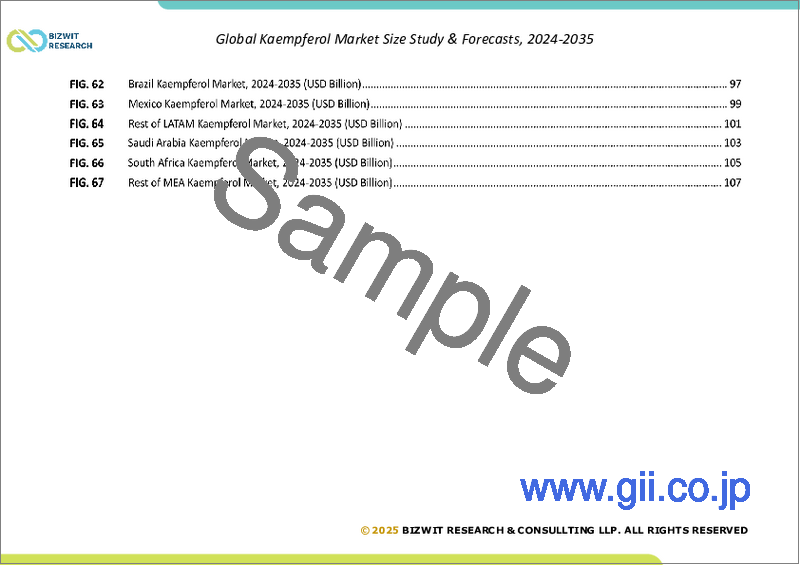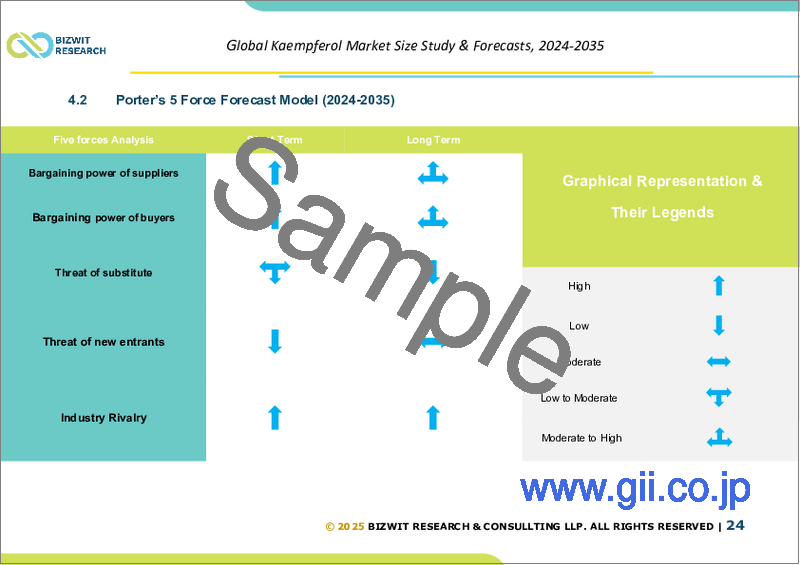|
|
市場調査レポート
商品コード
1703937
ケンフェロールの世界市場規模調査:純度別、用途別、地域別予測、2022年~2032年Global Kaempferol Market Size study, by Purity (10%, 20%, 50%, 95%, 98%), by Application (Food & Beverages, Cosmetics, Pharmaceuticals, Dietary Supplements) and Regional Forecasts 2022-2032 |
||||||
カスタマイズ可能
|
|||||||
| ケンフェロールの世界市場規模調査:純度別、用途別、地域別予測、2022年~2032年 |
|
出版日: 2025年04月10日
発行: Bizwit Research & Consulting LLP
ページ情報: 英文 285 Pages
納期: 2~3営業日
|
全表示
- 概要
- 目次
ケンフェロールの世界市場は、2023年に約40億6,000万米ドルと評価され、予測期間の2024年から2032年にかけて3.9%以上の安定した成長率で成長すると予測されています。
ケンフェロールは、野菜、果物、薬用植物に広く含まれる天然由来のフラボノイドで、科学的に裏付けられた抗酸化作用、抗炎症作用、抗菌作用、抗がん作用により、世界的に顕著な人気を集めています。消費者が天然の健康増進剤や植物由来のソリューションに引き寄せられる中、ケンフェロールは、栄養補助食品、医薬品、機能性食品の各分野の処方者や研究者にとっての焦点となりつつあります。慢性的な健康状態やライフスタイルに関連した疾患の増加を受け、その関連性は急上昇しており、メーカー各社は成分ポートフォリオを再考し、ウェルネス中心の処方でイノベーションを起こす必要に迫られています。
この拡大する市場は、消費者の認識の変化や、クリーンラベルや生物活性に富んだ製品開発への業界全体の傾倒によって後押しされています。食品・飲料用途で需要が加速する中、ケンフェロールは感覚プロファイルを維持しながら栄養効果を高めることができるため、製品開発者の間で好まれています。同様に、化粧品分野では、美白やアンチエイジング製品に貢献するフリーラジカル消去能力により、その用途が拡大しています。これと並行して、医薬品メーカーや栄養補助食品メーカーは、心血管疾患、神経変性疾患、代謝性疾患への対処を目的とした治療用製剤のために、ケンフェロールの高純度グレードを模索しています。しかし、ケンフェロールを大量に販売するためには、安定したバイオアベイラビリティと持続可能な抽出方法の確保が不可欠であり、業界はこの課題に直面しています。
生物抽出技術と生物工学の進歩は、ケンフェロールをより高収率で持続的に生産するための基礎を築きつつあります。超臨界流体抽出からグリーンケミストリー合成経路に至るまで、メーカー各社は環境意識の高まりや規制圧力に対応した、スケーラブルでコスト効率の高い方法を開発しつつあります。研究開発への投資が増加する中、治療やサプリメント用途で特に重要な溶解性と吸収性を高める新しいデリバリーシステムが研究されています。ケンフェロールは、ニッチな植物性食品から主流の生物活性食品への大胆なシフトを反映し、免疫強化複合体、向知性サプリメント、がんサポートレジメンなどの実験的ブレンドにも採用されています。
世界の健康動向は、予防ヘルスケア製品や日常的な食事療法におけるケンフェロールベースの成分に対する需要の急増を促しています。都市部の消費者は、ハーブサプリメントや抗酸化物質が豊富な食事を好むようになっており、このライフスタイルの変化が、栄養補助食品大手に、発泡性粉末から機能性ガムやオーガニックハーブインフュージョンまで、フラボノイド複合体を革新的な形態で取り入れるよう促しています。B2Bの面では、学術機関と産業界のプレーヤーとのコラボレーションが、成分革新のパイプラインを育成しています。また、いくつかの市場において、食品や医薬品のカテゴリーにおける植物抽出物に対する規制上の支援も、商品化を合理化しています。
地域別では、北米が天然成分に対する消費者の強い需要とサプリメント製造・流通の強固なインフラにより、ケンフェロール市場のトップランナーであり続けています。欧州は、ポリフェノール消費に関する意識の高まりと、天然添加物に対する規制の強化に支えられて、これに続いています。一方、豊富な天然素材と伝統的な医療システムを有するアジア太平洋地域は、特に中国、日本、インドからの需要が急増しています。ラテンアメリカと中東・アフリカは、eコマースの普及、可処分所得の増加、植物由来のウェルネスへの関心の再燃に支えられ、有望な地域として浮上しています。
目次
第1章 世界のケンフェロール市場:エグゼクティブサマリー
- 世界のケンフェロール市場規模・予測(2022年~2032年)
- 地域別概要
- セグメント別概要
- 純度別
- 用途別
- 主要動向
- 景気後退の影響
- アナリストの提言と結論
第2章 世界のケンフェロール市場:定義と調査の前提条件
- 調査目的
- 市場の定義
- 調査の前提条件
- 包含事項・除外事項
- 制限事項
- 供給側分析
- 可用性
- インフラ
- 規制の枠組み
- 市場競争
- 経済性(消費者の視点)
- 需要側分析
- 規制枠組み
- 技術的進歩
- 環境への配慮
- 消費者の意識と受容
- 調査手法
- 調査対象年
- 通貨換算レート
第3章 世界のケンフェロール市場力学
- 市場促進要因
- 天然健康増進剤に対する消費者の需要の高まり
- 慢性的な健康状態と生活習慣病の増加
- クリーンラベルおよび生理活性物質を豊富に含む製品の開発への重点化
- 市場の課題
- 一貫性のないバイオアベイラビリティと持続可能な抽出方法
- 規制と生産のスケーラビリティの問題
- 市場機会
- バイオ抽出とグリーンケミストリー合成の進歩
- 医薬品、化粧品、栄養補助食品への応用拡大
- 学術界と産業界の戦略的連携
第4章 世界のケンフェロール市場産業分析
- ポーターのファイブフォースモデル
- 供給企業の交渉力
- 買い手の交渉力
- 新規参入業者の脅威
- 代替品の脅威
- 競争企業間の敵対関係
- ポーターのファイブフォースモデルへの未来的アプローチ
- ポーターのファイブフォースの影響分析
- PESTEL分析
- 政治
- 経済
- 社会
- 技術
- 環境
- 法律
- 主要投資機会
- 主要成功戦略
- ディスラプションの動向
- 業界専門家の視点
- アナリストの提言と結論
第5章 世界のケンフェロール市場規模・予測:純度別、2022年~2032年
- セグメントダッシュボード
- 世界のケンフェロール市場:純度の収益動向分析、2022年・2032年
- 10%
- 20%
- 50%
- 95%
- 98%
第6章 世界のケンフェロール市場規模・予測:用途別、2022年~2032年
- セグメントダッシュボード
- 世界のケンフェロール市場:用途の収益動向分析、2022年・2032年
- 食品・飲料
- 化粧品
- 医薬品
- 栄養補助食品
第7章 世界のケンフェロール市場規模・予測:地域別、2022年~2032年
- 北米
- 米国
- カナダ
- 欧州
- 英国
- ドイツ
- フランス
- スペイン
- イタリア
- その他欧州地域
- アジア太平洋
- 中国
- インド
- 日本
- オーストラリア
- 韓国
- その他アジア太平洋
- ラテンアメリカ
- ブラジル
- メキシコ
- その他ラテンアメリカ地域
- 中東・アフリカ
- サウジアラビア
- 南アフリカ
- その他中東・アフリカ
第8章 競合情報
- 主要企業のSWOT分析
- Indena S.p.A.
- Aktin Chemicals Inc.
- Merck KGaA
- 主要市場の戦略
- 企業プロファイル
- Indena S.p.A.
- 主要情報
- 概要
- 財務(データの入手可能性によります)
- 製品概要
- 市場戦略
- Aktin Chemicals Inc.
- Shaanxi Guanjie Technology Co., Ltd.
- TCI Chemicals Pvt. Ltd.
- Merck KGaA
- Foodchem International Corporation
- Swanson Health Products
- BioVision Inc.
- Cayman Chemical Company
- Toronto Research Chemicals
- Xi'an Sost Biotech Co., Ltd.
- Xi'an Biof Bio-Technology Co., Ltd.
- Chengdu Biopurify Phytochemicals Ltd.
- Herblink Biotech Corporation
- Hunan Sunfull Bio-tech Co., Ltd.
- Indena S.p.A.
第9章 調査プロセス
- 調査プロセス
- データマイニング
- 分析
- 市場予測
- 検証
- 出版
- 調査の属性
Global Kaempferol Market is valued approximately at USD 4.06 billion in 2023 and is anticipated to grow with a steady growth rate of more than 3.9% over the forecast period 2024-2032. Kaempferol, a naturally occurring flavonoid widely found in vegetables, fruits, and medicinal plants, is gaining remarkable traction across the global landscape, owing to its scientifically-backed antioxidant, anti-inflammatory, antimicrobial, and anticancer properties. As consumers gravitate toward natural health boosters and plant-derived solutions, kaempferol is fast becoming a focal point for formulators and researchers across nutraceutical, pharmaceutical, and functional food sectors. Its relevance has soared in the wake of increasing chronic health conditions and lifestyle-related disorders, pushing manufacturers to rethink ingredient portfolios and innovate with wellness-centric formulations.
This expanding market is being buoyed by shifting consumer perceptions and an industry-wide inclination toward clean-label and bioactive-rich product development. As demand accelerates across food and beverage applications, kaempferol's ability to enhance nutritional efficacy while maintaining sensory profiles makes it a preferred choice among product developers. Similarly, in the cosmetics realm, its application is expanding due to its free radical scavenging abilities, which contribute to skin brightening and anti-aging products. In parallel, pharmaceutical and dietary supplement manufacturers are exploring high-purity grades of kaempferol for therapeutic formulations aimed at addressing cardiovascular, neurodegenerative, and metabolic ailments. However, the industry still contends with the challenge of ensuring consistent bioavailability and sustainable extraction methods, both of which are critical for scaling kaempferol into mass-market formulations.
Advancements in bio-extraction technologies and bioengineering are laying the foundation for higher-yield and more sustainable kaempferol production. From supercritical fluid extraction to green chemistry synthesis pathways, manufacturers are unlocking scalable and cost-effective methods that align with rising environmental consciousness and regulatory pressures. With escalating R&D investments, new delivery systems are being explored to enhance solubility and absorption, which is particularly important in therapeutic and supplement applications. Kaempferol is also being featured in experimental blends for immune-boosting complexes, nootropic supplements, and cancer-support regimens, reflecting a bold shift from niche botanical to mainstream bioactive.
Global health trends are catalyzing a surge in demand for kaempferol-based ingredients in preventive healthcare products and daily dietary solutions. Consumers in urban centers are increasingly favoring herbal supplements and antioxidant-rich diets, and this lifestyle shift is prompting nutraceutical giants to incorporate flavonoid complexes in innovative formats-from effervescent powders to functional gums and organic herbal infusions. On the B2B front, collaborations between academic institutions and industrial players are fostering ingredient innovation pipelines. Regulatory support for botanical extracts in food and pharma categories across several markets is also streamlining commercialization.
Regionally, North America remains a front-runner in the kaempferol market due to strong consumer demand for natural ingredients and robust infrastructure for supplement manufacturing and distribution. Europe is closely following, underpinned by rising awareness regarding polyphenol consumption and tightening regulatory endorsements for natural additives. Meanwhile, Asia Pacific-home to abundant natural sources of kaempferol and traditional medicine systems-is witnessing surging demand, especially from China, Japan, and India. Latin America and the Middle East & Africa are emerging as promising territories, supported by growing e-commerce penetration, increasing disposable income, and a resurging interest in botanical-based wellness.
Major market player included in this report are:
- Indena S.p.A.
- Aktin Chemicals Inc.
- Shaanxi Guanjie Technology Co., Ltd.
- TCI Chemicals Pvt. Ltd.
- Merck KGaA
- Foodchem International Corporation
- Swanson Health Products
- BioVision Inc.
- Cayman Chemical Company
- Toronto Research Chemicals
- Xi'an Sost Biotech Co., Ltd.
- Xi'an Biof Bio-Technology Co., Ltd.
- Chengdu Biopurify Phytochemicals Ltd.
- Herblink Biotech Corporation
- Hunan Sunfull Bio-tech Co., Ltd.
The detailed segments and sub-segment of the market are explained below:
By Purity
- 10%
- 20%
- 50%
- 95%
- 98%
By Application
- Food & Beverages
- Cosmetics
- Pharmaceuticals
- Dietary Supplements
By Region:
- North America
- U.S.
- Canada
- Europe
- UK
- Germany
- France
- Spain
- Italy
- Rest of Europe
- Asia Pacific
- China
- India
- Japan
- Australia
- South Korea
- Rest of Asia Pacific
- Latin America
- Brazil
- Mexico
- Middle East & Africa
- Saudi Arabia
- South Africa
- Rest of Middle East & Africa
Years considered for the study are as follows:
- Historical year - 2022
- Base year - 2023
- Forecast period - 2024 to 2032
Key Takeaways:
- Market Estimates & Forecast for 10 years from 2022 to 2032.
- Annualized revenues and regional level analysis for each market segment.
- Detailed analysis of geographical landscape with country level analysis of major regions.
- Competitive landscape with information on major players in the market.
- Analysis of key business strategies and recommendations on future market approach.
- Analysis of competitive structure of the market.
- Demand side and supply side analysis of the market.
Table of Contents
Chapter 1. Global Kaempferol Market Executive Summary
- 1.1. Global Kaempferol Market Size & Forecast (2022-2032)
- 1.2. Regional Summary
- 1.3. Segmental Summary
- 1.3.1. {By Purity}
- 1.3.2. {By Application}
- 1.4. Key Trends
- 1.5. Recession Impact
- 1.6. Analyst Recommendation & Conclusion
Chapter 2. Global Kaempferol Market Definition and Research Assumptions
- 2.1. Research Objective
- 2.2. Market Definition
- 2.3. Research Assumptions
- 2.3.1. Inclusion & Exclusion
- 2.3.2. Limitations
- 2.3.3. Supply Side Analysis
- 2.3.3.1. Availability
- 2.3.3.2. Infrastructure
- 2.3.3.3. Regulatory Environment
- 2.3.3.4. Market Competition
- 2.3.3.5. Economic Viability (Consumer's Perspective)
- 2.3.4. Demand Side Analysis
- 2.3.4.1. Regulatory Frameworks
- 2.3.4.2. Technological Advancements
- 2.3.4.3. Environmental Considerations
- 2.3.4.4. Consumer Awareness & Acceptance
- 2.4. Estimation Methodology
- 2.5. Years Considered for the Study
- 2.6. Currency Conversion Rates
Chapter 3. Global Kaempferol Market Dynamics
- 3.1. Market Drivers
- 3.1.1. Growing consumer demand for natural health boosters
- 3.1.2. Rising chronic health conditions and lifestyle-related disorders
- 3.1.3. Increased focus on clean-label and bioactive-rich product development
- 3.2. Market Challenges
- 3.2.1. Inconsistent bioavailability and sustainable extraction methods
- 3.2.2. Regulatory and production scalability issues
- 3.3. Market Opportunities
- 3.3.1. Advancements in bio-extraction and green chemistry synthesis
- 3.3.2. Expanding applications in pharmaceuticals, cosmetics, and dietary supplements
- 3.3.3. Strategic collaborations between academia and industry
Chapter 4. Global Kaempferol Market Industry Analysis
- 4.1. Porter's 5 Force Model
- 4.1.1. Bargaining Power of Suppliers
- 4.1.2. Bargaining Power of Buyers
- 4.1.3. Threat of New Entrants
- 4.1.4. Threat of Substitutes
- 4.1.5. Competitive Rivalry
- 4.1.6. Futuristic Approach to Porter's 5 Force Model
- 4.1.7. Porter's 5 Force Impact Analysis
- 4.2. PESTEL Analysis
- 4.2.1. Political
- 4.2.2. Economical
- 4.2.3. Social
- 4.2.4. Technological
- 4.2.5. Environmental
- 4.2.6. Legal
- 4.3. Top Investment Opportunity
- 4.4. Top Winning Strategies
- 4.5. Disruptive Trends
- 4.6. Industry Expert Perspective
- 4.7. Analyst Recommendation & Conclusion
Chapter 5. Global Kaempferol Market Size & Forecasts by Purity 2022-2032
- 5.1. Segment Dashboard
- 5.2. Global Kaempferol Market: {Purity} Revenue Trend Analysis, 2022 & 2032 (USD Million/Billion)
- 5.2.1. 10%
- 5.2.2. 20%
- 5.2.3. 50%
- 5.2.4. 95%
- 5.2.5. 98%
Chapter 6. Global Kaempferol Market Size & Forecasts by Application 2022-2032
- 6.1. Segment Dashboard
- 6.2. Global Kaempferol Market: {Application} Revenue Trend Analysis, 2022 & 2032 (USD Million/Billion)
- 6.2.1. Food & Beverages
- 6.2.2. Cosmetics
- 6.2.3. Pharmaceuticals
- 6.2.4. Dietary Supplements
Chapter 7. Global Kaempferol Market Size & Forecasts by Region 2022-2032
- 7.1. North America Kaempferol Market
- 7.1.1. U.S. Kaempferol Market
- 7.1.1.1. {Purity} breakdown size & forecasts, 2022-2032
- 7.1.1.2. {Application} breakdown size & forecasts, 2022-2032
- 7.1.2. Canada Kaempferol Market
- 7.1.1. U.S. Kaempferol Market
- 7.2. Europe Kaempferol Market
- 7.2.1. U.K. Kaempferol Market
- 7.2.2. Germany Kaempferol Market
- 7.2.3. France Kaempferol Market
- 7.2.4. Spain Kaempferol Market
- 7.2.5. Italy Kaempferol Market
- 7.2.6. Rest of Europe Kaempferol Market
- 7.3. Asia-Pacific Kaempferol Market
- 7.3.1. China Kaempferol Market
- 7.3.2. India Kaempferol Market
- 7.3.3. Japan Kaempferol Market
- 7.3.4. Australia Kaempferol Market
- 7.3.5. South Korea Kaempferol Market
- 7.3.6. Rest of Asia-Pacific Kaempferol Market
- 7.4. Latin America Kaempferol Market
- 7.4.1. Brazil Kaempferol Market
- 7.4.2. Mexico Kaempferol Market
- 7.4.3. Rest of Latin America Kaempferol Market
- 7.5. Middle East & Africa Kaempferol Market
- 7.5.1. Saudi Arabia Kaempferol Market
- 7.5.2. South Africa Kaempferol Market
- 7.5.3. Rest of Middle East & Africa Kaempferol Market
Chapter 8. Competitive Intelligence
- 8.1. Key Company SWOT Analysis
- 8.1.1. Indena S.p.A.
- 8.1.2. Aktin Chemicals Inc.
- 8.1.3. Merck KGaA
- 8.2. Top Market Strategies
- 8.3. Company Profiles
- 8.3.1. Indena S.p.A.
- 8.3.1.1. Key Information
- 8.3.1.2. Overview
- 8.3.1.3. Financial (Subject to Data Availability)
- 8.3.1.4. Product Summary
- 8.3.1.5. Market Strategies
- 8.3.2. Aktin Chemicals Inc.
- 8.3.3. Shaanxi Guanjie Technology Co., Ltd.
- 8.3.4. TCI Chemicals Pvt. Ltd.
- 8.3.5. Merck KGaA
- 8.3.6. Foodchem International Corporation
- 8.3.7. Swanson Health Products
- 8.3.8. BioVision Inc.
- 8.3.9. Cayman Chemical Company
- 8.3.10. Toronto Research Chemicals
- 8.3.11. Xi'an Sost Biotech Co., Ltd.
- 8.3.12. Xi'an Biof Bio-Technology Co., Ltd.
- 8.3.13. Chengdu Biopurify Phytochemicals Ltd.
- 8.3.14. Herblink Biotech Corporation
- 8.3.15. Hunan Sunfull Bio-tech Co., Ltd.
- 8.3.1. Indena S.p.A.
Chapter 9. Research Process
- 9.1. Research Process
- 9.1.1. Data Mining
- 9.1.2. Analysis
- 9.1.3. Market Estimation
- 9.1.4. Validation
- 9.1.5. Publishing
- 9.2. Research Attributes





